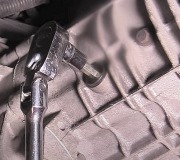At first I thought you did it right, until I looked up the specs. They list 13.0 quarts, but that is only for a newly-rebuilt transmission that is empty of fluid. Normally when we do a drain and fill, which is most common and what you did, we only get out very close to half of that fluid. The rest is captive in the drums and clutch packs, and in the passages and torque converter. Replacing half of the fluid is enough to replenish the additives that wear out over time.
In your transmission, they say only 2.1 quarts will drain out. That surprised me, but in this case it is over-filled by almost three quarts. What's going to happen is fluid will be high enough to surround the rotating parts. That will fling it around and whip air into it. Since air can be compressed, there won't be enough fluid pressure holding the clutch plates engaged. They'll slip, possibly only under hard acceleration, or possibly only at highway speed. Normally the only time the clutch plates wear is for a fraction of a second when they're engaging and disengaging during shifts. Slipping while driving at a steady speed can do thousands of miles worth of wear in a few days.
The leakage you saw was caused by the fluid foaming up, then reaching the vent where it was expelled. It will never expel enough to get down to the correct level, so you'll have to drain some fluid out yourself. I'd be very suspicious that will be the end of the story with no lasting performance problems.
Image (Click to make bigger)
Saturday, May 1st, 2021 AT 7:44 PM




